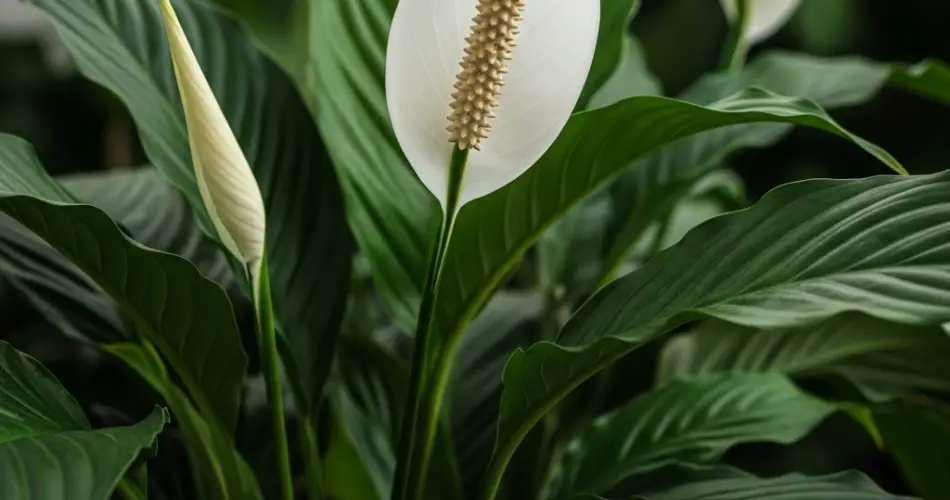The peace lily (Spathiphyllum) is a popular houseplant known for its lush green foliage and elegant white flowers. It’s often chosen for indoor spaces due to its air-purifying qualities and ease of care. However, if you’re a pet owner, you may be wondering whether this beautiful plant is safe to keep around cats and dogs. Unfortunately, peace lilies are considered toxic to pets, and it’s important to understand the risks involved to ensure the safety of your furry companions.
This article will explain why peace lilies are toxic, what symptoms to look for, and how to keep your pets and plants in harmony.
Are Peace Lilies Toxic to Pets?
Yes, peace lilies are toxic to both cats and dogs. While they are not as dangerous as true lilies (like Easter or tiger lilies, which can be fatal to cats even in small amounts), peace lilies still pose a significant risk if ingested.
The primary toxic agent in peace lilies is insoluble calcium oxalate crystals. These microscopic, needle-shaped crystals are present in all parts of the plant—leaves, stems, and flowers. When a pet chews or bites into the plant, the crystals are released and can penetrate the soft tissues of the mouth, throat, and digestive tract, causing irritation and discomfort.
Symptoms of Peace Lily Poisoning in Pets
If your cat or dog chews on or ingests part of a peace lily, they may begin to show symptoms within minutes. The severity can vary depending on how much of the plant was consumed and the size of the animal.
Common signs of peace lily poisoning include:
-
Drooling or excessive salivation
-
Pawing at the mouth
-
Oral pain or swelling
-
Difficulty swallowing
-
Vomiting
-
Loss of appetite
-
Mild difficulty breathing (in rare cases)
In most cases, the reaction is mild to moderate, but it can still be distressing for the pet and the owner. Very small pets or those with pre-existing health issues may experience more severe symptoms.
What to Do If Your Pet Eats a Peace Lily
If you suspect that your pet has chewed or eaten part of a peace lily, take action promptly:
-
Rinse their mouth: Use cool water to gently flush your pet’s mouth and remove any plant residue. Be careful not to force water into their throat.
-
Offer something soothing: Giving your pet a small amount of milk or yogurt can help neutralize irritation from calcium oxalate crystals.
-
Monitor symptoms: Watch your pet closely for signs of distress, including swelling, vomiting, or difficulty breathing.
-
Call your veterinarian: Even if symptoms appear mild, it’s a good idea to contact your vet for guidance. Describe the plant, how much was eaten, and the symptoms observed.
-
Seek emergency care: If your pet shows signs of severe swelling, persistent vomiting, or trouble breathing, seek emergency veterinary treatment immediately.
Safe Alternatives to Peace Lilies
If you love houseplants but want to avoid any risk to your pets, consider replacing your peace lily with non-toxic alternatives. Here are a few pet-safe houseplants:
-
Spider plant (Chlorophytum comosum): Attractive, air-purifying, and non-toxic to pets.
-
Areca palm (Dypsis lutescens): A tropical-looking plant that’s completely safe for cats and dogs.
-
Calathea: Known for its stunning patterns and colors, and safe for pets.
-
Prayer plant (Maranta leuconeura): A beautiful, non-toxic option for indoor spaces.
-
Peperomia: Compact and easy to care for, with dozens of safe, decorative varieties.
Tips for Keeping Peace Lilies Out of Reach
If you’re set on keeping your peace lily, it’s crucial to ensure your pets can’t access it. Here are some practical strategies:
-
Place plants on high shelves or hanging baskets far from your pet’s usual roaming areas.
-
Use deterrent sprays with pet-safe ingredients that discourage chewing.
-
Train pets early to stay away from plants using commands or positive reinforcement.
-
Create a pet-safe zone in your home where only non-toxic plants are allowed.
Final Thoughts
While peace lilies are beautiful and beneficial in many ways, they do pose a risk to pets if chewed or ingested. Knowing the signs of toxicity and taking preventive measures can help protect your cats and dogs while still enjoying your indoor greenery. If you’re concerned about safety, consider switching to pet-friendly alternatives that offer the same aesthetic appeal without the worry. With a little planning, it’s entirely possible to have a home filled with both happy pets and healthy plants.



